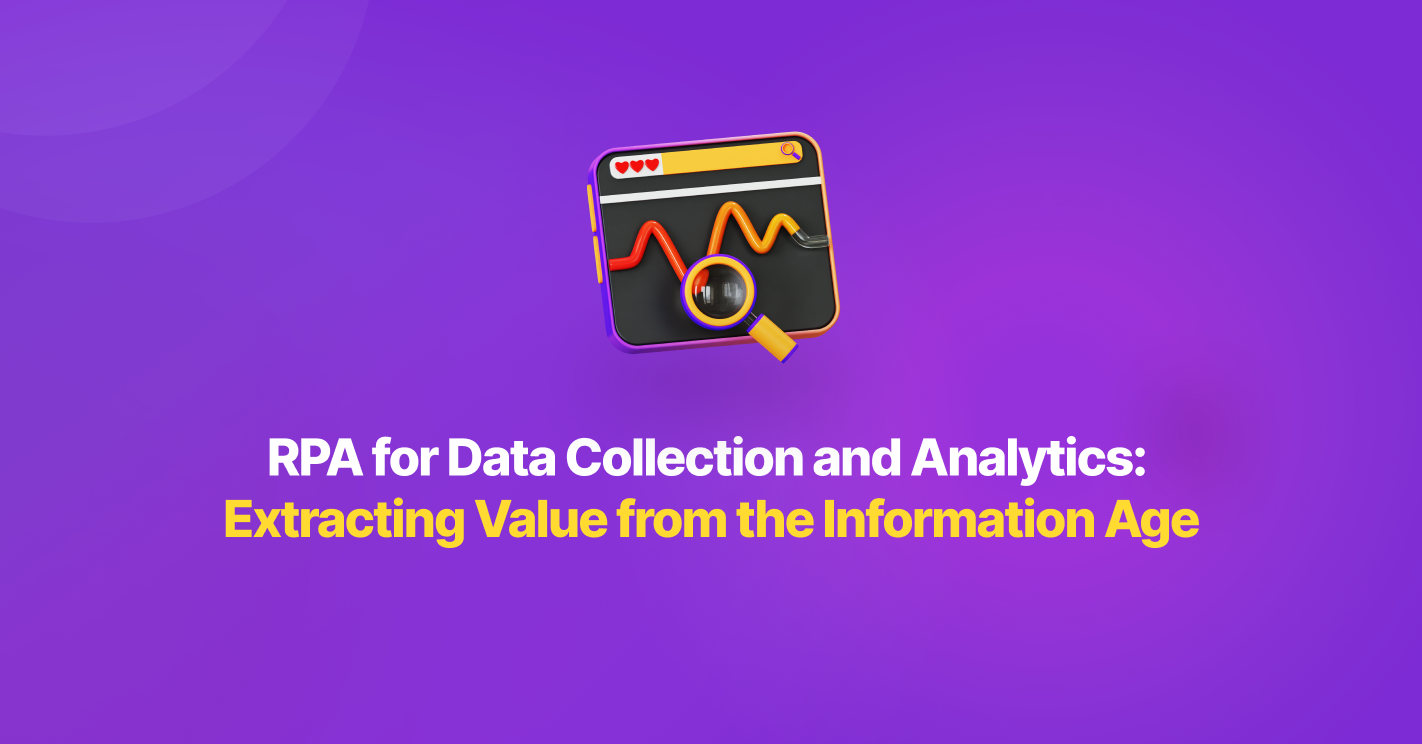The demand for streamlined data collection and analytics processes has surged in the face of
the information age’s paradox: organizations are drowning in data but struggling to extract
meaningful insights. With a focus on automating repetitive tasks and enhancing accuracy,
Robotic Process Automation (RPA) emerges as a transformative toolset.
In this article, we delve into the key benefits and strategies of using RPA to navigate beyond the
data swamp.
Beyond the Data Swamp
In an era where data is abundant, yet underutilized, manual data collection often proves
laborious, error-prone, and inefficient. RPA becomes the lifeline, offering a pathway to
data-driven success by significantly improving efficiency, accuracy, and flexibility.
How RPA Works in Data Collection
RPA mimics human interactions with digital systems, deploying software “bots” to automate
rule-based tasks. The impact is profound, bringing about increased efficiency, improved
accuracy, flexibility, and substantial cost savings.
- Increased efficiency: Bots tirelessly work 24/7, reducing data collection time and optimizing resource allocation. For instance, they can automatically extract customer feedback from online forms, aggregate sales data from multiple platforms, and compile market research statistics from different databases. By operating 24/7 without breaks, these bots ensure continuous data collection, thereby optimizing resource allocation and minimizing downtime.
- Improved accuracy: In data collection, precision is paramount, and RPA excels in eliminating human errors. By automating repetitive tasks like data entry and extraction, RPA ensures consistent and error-free data capture. For example, RPA bots can accurately transcribe data from scanned documents, reducing the risk of typos or misinterpretations. This heightened accuracy enhances data integrity and reliability, providing a solid foundation for informed decision-making.
- Flexibility: Data collection often involves interfacing with diverse sources and formats. RPA bots exhibit remarkable adaptability, seamlessly integrating with various systems and data structures. Whether it’s extracting customer information from web forms, parsing data from PDFs, or interfacing with APIs to retrieve real-time data, RPA bots can handle a wide range of data sources and formats. This flexibility simplifies the integration process, enabling organizations to efficiently gather data from disparate sources without manual intervention.
- Cost savings: By automating data collection processes, RPA significantly reduces the need for manual labor, resulting in substantial cost savings. For instance, instead of employing personnel to manually input data from invoices or extract information from emails, organizations can deploy RPA bots to perform these tasks with higher efficiency and accuracy. The reduction in human involvement not only cuts labor costs but also minimizes the potential for costly errors or delays.
RPA for Data Analytics and Migration
RPA’s impact extends beyond mere automation; it acts as a catalyst, transforming raw data into
a powerful fuel for insightful analysis. Simply put, RPA serves as the construction crew ensuring
a stable foundation for data analysis through:
- Automating data entry: RPA bots flawlessly transfer data between systems and forms, eliminating manual entry errors and ensuring data integrity.
- Streamlined data migration: Complex data migration challenges during mergers and acquisitions are tackled seamlessly by RPA bots, ensuring a complete picture for analysis.
- Continuous data cleaning: RPA bots monitor data, automatically detecting and correcting errors, leading to cleaner and more reliable analysis.
- Real-time data replication: RPA bots capture insights from constantly evolving data streams in real-time, providing an updated analysis landscape.
- Enhanced data aggregation: RPA effortlessly gathers data from diverse sources, applications, and formats, creating a unified dataset ready for advanced analytics.
- Advanced analytics integration: RPA bridges the gap between data and advanced analytics like machine learning, automating repetitive tasks, and allowing analysts to focus on meaningful insights.
- Automated reporting: RPA bots take charge of report generation, pulling data, and creating tailored reports, freeing up valuable analyst time.
- Predictive analytics powerhouse: Historical data from RPA-automated processes feeds into machine learning models, enabling organizations to predict future trends and make data-driven decisions.
More Than Just Efficiency
RPA transcends time and resource savings by digitizing processes. Through data enrichment, RPA helps with insightful analysis by generating an abundance of data points compared to manual processes, thereby offering deeper insights that fuel continuous process improvement. Simultaneously, RPA plays a pivotal role in eliminating subjectivity by removing human bias
during manual reviews, ensuring the delivery of objective data and fostering more reliable insights. The transformative impact of RPA extends to organizational decision-making, empowering businesses with data-driven insights derived from RPA-generated data. This, in turn, enables informed decision-making, process optimization, and provides a competitive edge in the dynamic business landscape.
Real-World Applications
RPA’s value is evident across industries:
- Financial services: Automating bank statement downloads, loan processing, and fraud detection.
- Healthcare: Collecting patient data, automating claims processing, and generating reports
- Retail: Extracting sales data, automating inventory management, and analyzing customer behavior.
- Manufacturing: Monitoring production lines, collecting sensor data, and generating performance reports.
Implementing RPA for Your Data Needs
Embarking on a successful RPA implementation involves a systematic approach. The initial step is to meticulously identify tasks suitable for automation within existing workflows. Subsequently, a thorough evaluation of RPA solutions based on specific needs and budget considerations is imperative. Following this, the design and development of RPA bots with well-defined rules and workflows come into play, ensuring seamless integration with existing systems and analytics tools. The process culminates in a comprehensive phase of testing, monitoring, and refining the RPA implementation to guarantee optimal performance and the attainment of desired automation outcomes.
Conclusion
In a world inundated with information, RPA is the key to unlocking the true potential of data. By leveraging RPA, organizations can transform data from a burden into a strategic asset, driving informed decisions, cost savings, and a competitive edge. Take the first step today and unleash the power of RPA to fuel your data-driven future.
For tailored RPA solutions and expert guidance, consider reaching out to Mitrais, your trusted
partner in navigating the transformative landscape of automation. Contact us today to unlock the full potential of RPA for your business needs!











